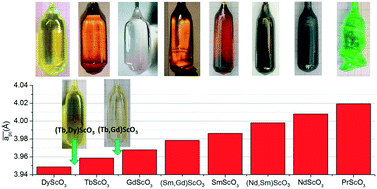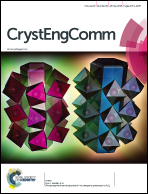Czochralski growth and characterization of TbxGd1−xScO3 and TbxDy1−xScO3 solid-solution single crystals†
Abstract
TbxGd1−xScO3 and TbxDy1−xScO3 solid-solution single crystals were grown by the Czochralski method to validate the practicality of solid solutions between neighboring RE scandates (REScO3). Within this material family, it is demonstrated that fine-tuning the pseudo-cubic lattice parameters between nearly all endmembers is now possible by adjusting the chemical composition of the mixed crystals. Film-tailored substrate lattice spacings enable fine adjustments of epitaxial strain or the growth of nearly strain-free heteroepitaxial films. Investigations of the chemical composition of the grown crystals revealed low segregation, which qualifies the solid-solutions as suitable substrate materials. The melting behavior was studied by differential thermal analysis. To calculate the thermal conductivity, λ(T), the heat capacity and thermal diffusivity were measured by differential scanning calorimetry and the laser flash technique, respectively. It was found that the thermal conductivity shows a minimum near 900 K and increases untypically at higher temperatures.



 Please wait while we load your content...
Please wait while we load your content...